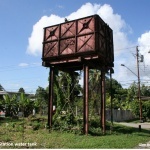

Loading…
Address: Caparo Valley Brasso Road




Town/City: Caparo
Region: Couva – Tabaquite – Talparo
Site Type: Cultural Heritage
Ownership: Public
Public Accessibility: Full Access
Cultural Community: British
Site Features: Railway Sites
History of Caparo Railway Station on the Caparo Valley Railway Line (By Glen Beadon):
The idea behind building a railway into the middle of Trinidad in the 1890s was a speculative move by the Colonial Government to sell crown property, encourage settlement, exploit natural resources and boost cultivation of virgin but very fertile lands.
The principal objective, as described by the Legislative Council, was “The opening up of the cultivation of some of the best lands in the Colony”. It was also intended by means of the railway to afford means of transport to the owners of already cultivated lands lying beyond the easy reach of the existing main roads and railways. It was recognised that a railway through the Caparo Valley would not be financially lucrative for many years until the area had further developed. The new line was to be an investment for future prosperity.
The first part of the line was 15 miles 5 chains in length and cost £118,466 (about £13.4M in today’s money). Work began on 26 March of 1896. The line joined the TGR’s southern main line at Cunupia Farm Junction (later Jerningham Junction) and ran in a southeasterly direction through the Caparo valley to Tabaquite. The Junction was later named after the Governor of the day, Sir Hubert Jerningham.
On 1 January of 1898, the Trinidad Government Railway opened the line from Jerningham
Junction to Brasso a distance of 12 1/4 miles. In order to reach the district of Tabaquite, the TGR was faced with perhaps the most testing engineering challenge in the history of the railway. A 660ft long tunnel was required in order to drive the line under a section of Trinidad’s central range.
The work on the Tabaquite tunnel was started on 26 November 1896 and was completed on 18 May 1897. The line was officially opened through the tunnel to Tabaquite from Brasso a distance of 2 3/4 miles on 20 August 1898. This line became known as the ‘Caparo Valley
Line’.
When the line first opened, there were only six stations beyond Jerningham Junction; Longdenville, Todd’s Road, Caparo, Brasso Pierda and Tabaquite. It was originally intended to have five stations, but afterwards it was decided to build another at Todd’s Road.
In 1914 the railway was extended another 12 miles 71.55 chains from Tabaquite to Rio Claro and then became known as the “Rio Claro Line”.
The railway operated for 67 years through the station at Caparo until it was closed, along with the rest of the line to Rio Claro, on 30 August 1965.
Today the site of Caparo Railway Station is relatively well preserved as compared to other railway stations in Trinidad. There still exists evidence of the station platform, water tank and water crane (known as water column) and although the station building has long been demolished, the steps leading to the building and platform are extant.
[mk_custom_sidebar sidebar=”map-location-widget”]
Caparo Valley Brasso Road, Caparo, Couva – Tabaquite – Talparo

